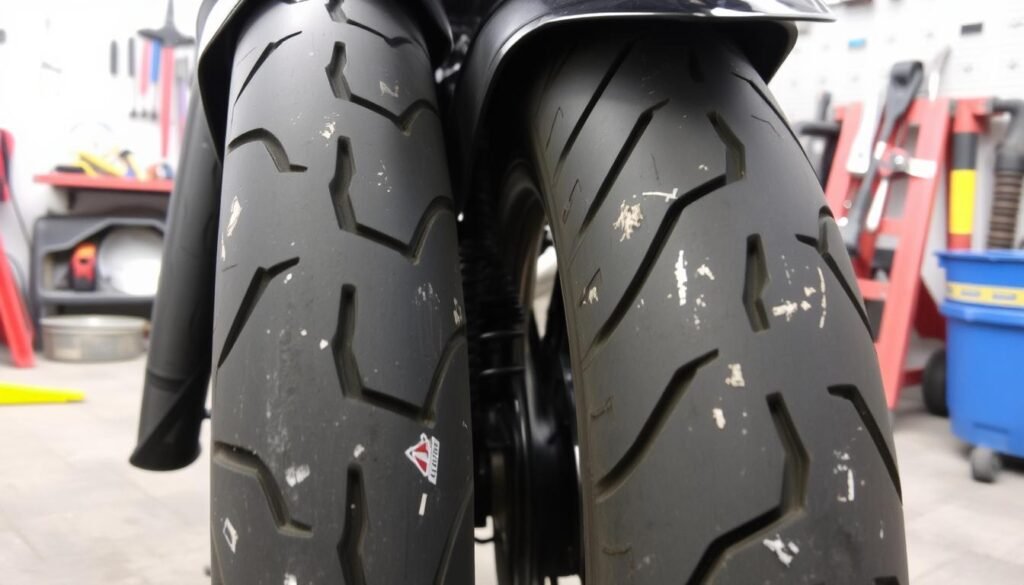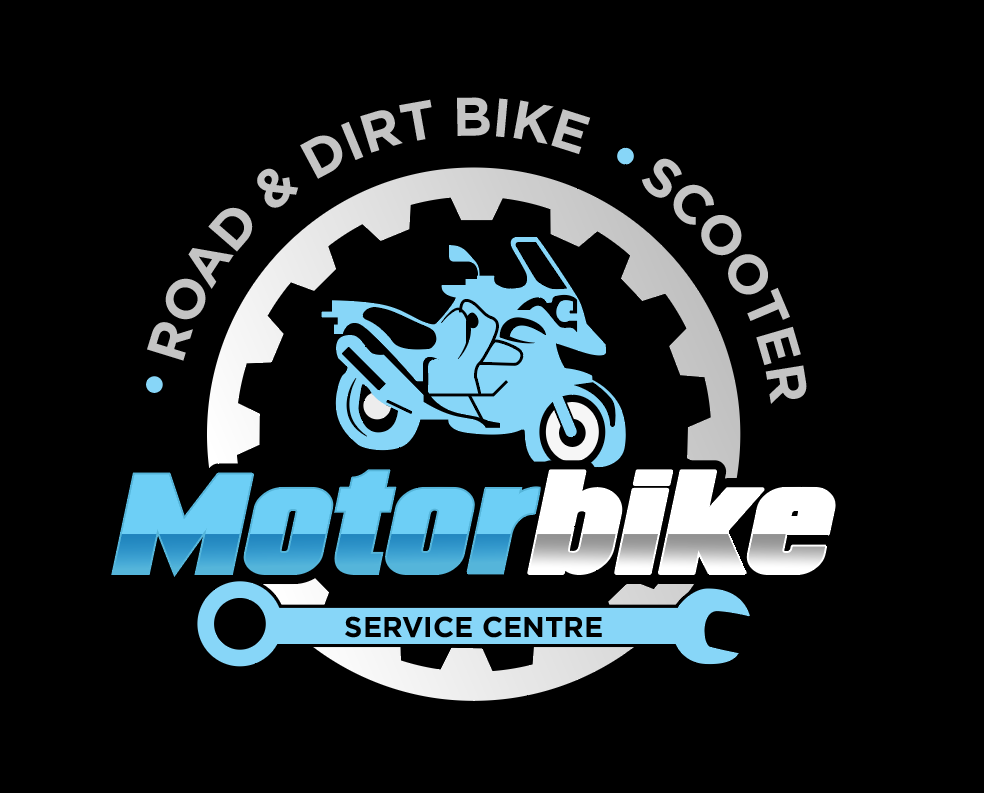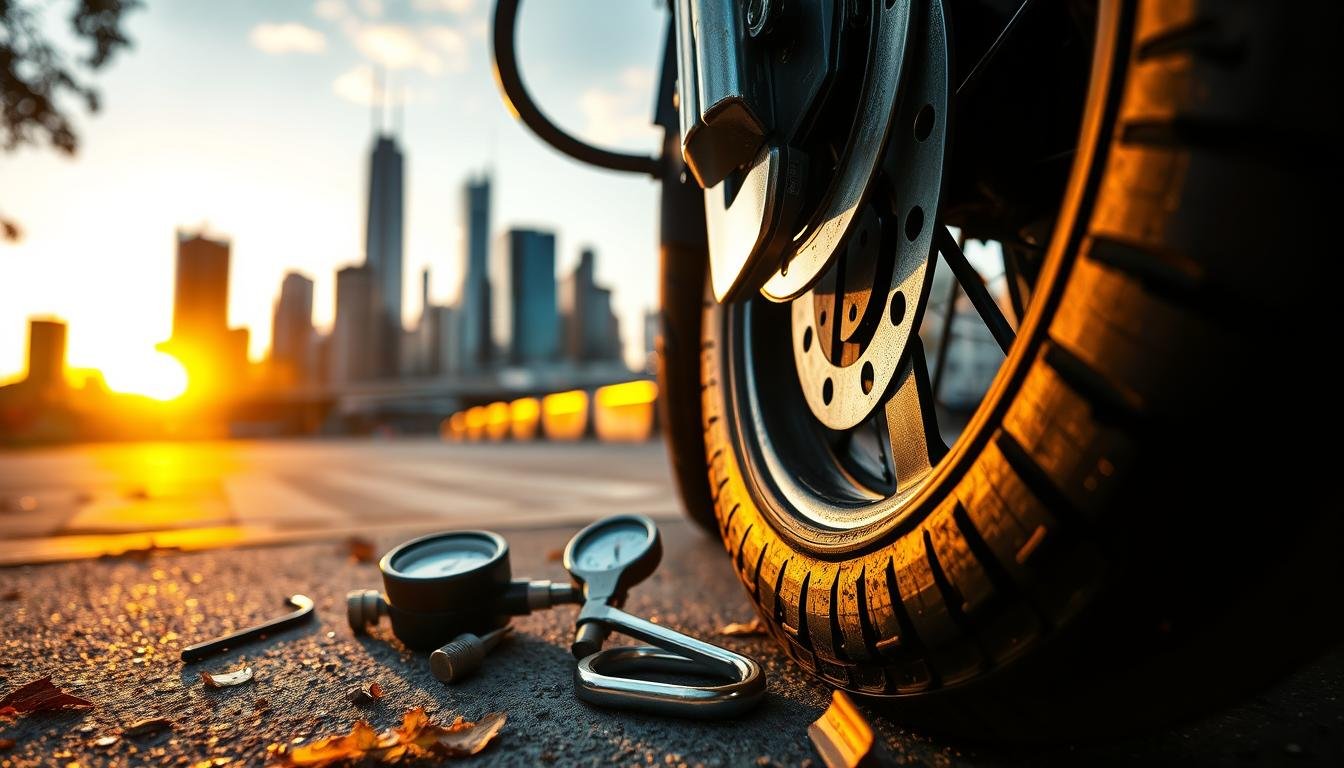Maintaining your motorcycle tyres is crucial for ensuring your safety and optimizing performance on Melbourne’s diverse roads. This comprehensive guide covers essential Motorcycle Tyre Maintenance Tips, focusing on important areas like Tyre Pressure Checks, Tyre Tread Depth, and safety considerations. Regular maintenance not only prevents accidents but also extends the lifespan of your tyres. A smooth and secure riding experience begins with understanding and implementing proper tyre care techniques tailored to your motorcycle’s needs.
Key Takeaways
- Regular tyre pressure checks are recommended every two weeks.
- Your tyres should ideally be kept at 32 psi for sporty riding or 40 psi for longevity.
- Underinflated tyres can accelerate wear and affect handling, leading to dangerous conditions.
- Proper maintenance can save money on repairs and ensure a more comfortable ride.
- Highly recommended to use pure nitrogen gas for improved stability in tyre pressure.
- Northside Motorcycle Tyres and Service is a reliable option for all your tyre needs.
Understanding the Importance of Motorcycle Tyre Maintenance
Motorcycle tyre maintenance significantly impacts your safety and the overall performance of your bike. Maintaining your tyres not only prolongs their longevity but also enhances your riding experience, especially in challenging conditions. Worn or damaged tyres can severely affect control, increasing the risk of accidents. For instance, front tyres generally last about 6000 km, while rear tyres might only last around 2900 km, particularly on sports bikes with spirited riding characteristics.
Adhering to recommended practices for tyre care improves not just the longevity of your tyres, but it also directly correlates with ensuring motorcycle safety. Regular checks for tread depth are necessary, as the minimum tread depth limit for safe riding is 1.6 mm. Insufficient tread can lead to decreased grip, especially in wet conditions, putting you at risk.
Proper maintenance includes addressing issues such as low tyre pressure, which can result in premature wear and reduce fuel efficiency. Overinflated tyres can create a harsh and uncomfortable ride. Gentle braking techniques can also prolong tyre life; you should apply light pressure on both brakes while gradually increasing pressure on the front brake.
Consulting tyre experts for safety assessments is strongly recommended. They can provide guidance on tyre installation and balancing, which are vital for ensuring optimal performance. Keeping your motorcycle tyres in prime condition will enhance their performance and overall riding safety.
Regular Tyre Pressure Checks
Maintaining proper tyre pressure is essential for your safety and the performance of your motorcycle. Regular Tyre Pressure Checks help ensure your bike handles well and that you achieve optimal fuel efficiency. Checking tyre pressure should be done weekly, especially before long rides, to catch any potential issues before they escalate.
How to Check Your Tyre Pressure
To accurately check your tyre pressure, follow these steps:
- Locate the valve stem on your tyre and remove the cap.
- Using a reliable pressure gauge, apply it firmly to the stem to get a reading.
- Ensure your tyres are cold for accurate results by checking them before you ride.
- Compare the reading against the recommended Tyre Pressure Ranges provided by your motorcycle manufacturer.
It is crucial to note that service station gauges can sometimes be inaccurate. Always rely on a quality personal gauge for the most precise readings.
Recommended Tyre Pressure Ranges
Maintaining your tyres within the recommended pressure ranges enhances your motorcycle’s performance and safety. Here are general guidelines:
- Older street bikes: Ideal pressure is around 34/36 psi.
- Modern bikes: Pressure could go up to 36/42 psi.
- Avoid under-inflation, as it leads to sluggish handling and increased tyre wear.
- Avoid over-inflation, which can cause a premature worn-out center tread and reduced grip.
By consistently adhering to recommended Tyre Pressure Ranges, you can enhance Motorcycle Safety while prolonging the life of your tyres.
Tyre Tread Depth Inspection
Understanding and maintaining your motorcycle’s tyre tread depth is vital for ensuring Tread Depth Safety and optimal performance. Adequate tread depth allows for appropriate grip on the road, especially under adverse weather conditions. Regular Tyre Tread Depth Inspection can prevent accidents and extend the life of your tyres.
Importance of Tread Depth for Safety
Your motorcycle’s tyres play a crucial role in its overall safety. In Australia, the legal minimum for tread depth is 1.6 mm, which directly impacts traction and handling. Worn-out tyres can significantly diminish your ability to stop effectively, especially on wet surfaces. As a rule of thumb, consider changing your tyres when tread depth approaches 3 mm to enhance safety and performance.
How to Measure Tread Depth
Measuring tread depth can be easily done using a tread depth gauge or the penny test. To perform the penny test, place a coin into the tread groove. If you can see the top of Abraham Lincoln’s head, your tread depth is too low. Regular checks help ensure that your tyres remain within safe limits. Keeping track of tread depth fosters a proactive approach to motorcycle maintenance.
Signs of Worn-Out Tyres
Recognizing signs of worn-out tyres is vital for ensuring your safety on the road. Regular checks can help you identify issues early, preventing potentially hazardous situations during rides.
Visual Checks for Damage
Conducting a thorough visual damage check is essential for maintaining your motorcycle’s performance. Look for:
- Cracks or deformations on the sidewalls
- Punctures or cuts in the tread area
- Bulging or unusual shapes
- Signs of tread wear such as bald patches or uneven patterns
These indicators of worn-out tyres can significantly impact your ride quality and safety.
Legal Minimum Tread Depth
The legal minimum tread depth for motorcycle tyres in Australia is set at 1.5 mm, but maintaining depths above this is advisable. As tyres age and wear down, their grip can decrease, resulting in a higher risk of accidents. Regular checks using tread wear indicators can help ensure your tyres are within legal limits and safe for riding.
Remember the average lifespan of a motorcycle tyre is around five years, but replacing them at ten years is recommended, regardless of how they appear. You can find the production date indicated by a four-digit DOT number on the sidewall, marking the week and year of manufacture.
| Tyre Age | Signs of Worn-Out Tyres | Recommended Action |
|---|---|---|
| Less than 5 years | No visible damage, adequate tread depth | Regular inspections |
| 5 to 10 years | Potential surface cracks, reduced grip | Consider replacement, seek professional advice |
| Over 10 years | Cracked, deformed, or significantly worn | Immediate replacement required |

Tyre Rotation for Even Wear
Proper maintenance of your motorcycle’s tyres directly influences safety and performance. Tyre rotation is crucial for ensuring even wear among your tyres, which extends their lifespan and enhances your ride’s consistency. Different styles of riding and road conditions lead to varied wear patterns, particularly between front and rear tyres. Regularly rotating your tyres optimizes their performance and ensures a safer ride.
Why Rotate Your Tyres?
Engaging in tyre rotation every 5,000 to 8,000 km is essential for achieving even wear across your motorcycle tyres. A lack of rotation can lead to irregular wear patterns, adversely affecting handling and traction. In many cases, over-inflation or under-inflation can exacerbate these issues, intensifying wear and impacting overall performance.
Rotating tyres provides several advantages:
- Promotes even wear, maximizing tread life.
- Enhances grip and handling characteristics for improved safety.
- Reduces stress on drivetrain components in all-wheel-drive systems.
- Facilitates visual inspections for any signs of damage or wear.
Incorporating a periodic rotation schedule not only optimizes your motorcycle’s performance but also ensures that you are riding safely. Long-term tyre health contributes significantly to the overall safety and reliability of your motorcycle.
Professional Tyre Balancing
Professional tyre balancing is an essential aspect of motorcycle maintenance that can greatly impact your riding experience. Achieving balanced tyres optimizes motorcycle performance and minimizes issues that arise from imbalances, such as excessive vibrations. Ensuring your tyres are balanced correctly contributes to greater comfort and enhanced handling. This practice not only improves the longevity of your tyres but also increases your overall safety on the road.
Benefits of Balanced Tyres
Investing in professional tyre balancing provides several balanced tyres benefits. Consider these advantages:
- Improved handling and stability during rides
- Increased comfort, reducing rider fatigue
- Significantly reduced vibrations, leading to a smoother experience
- Extended lifespan of tyres, delaying the need for replacements
- Enhanced fuel efficiency, supporting better overall performance
To maintain optimal motorcycle performance, schedule regular tyre balancing and consult qualified services for accurate assessments. By prioritizing this aspect of bike maintenance, you not only safeguard your investment in tyres but also elevate your riding experience, making it safer and more enjoyable.
| Aspect | Without Professional Balancing | With Professional Balancing |
|---|---|---|
| Tyre Lifespan | Shorter due to uneven wear | Longer lifespan with even wear |
| Riding Comfort | Increased vibrations, uncomfortable | Smoother ride, enhanced comfort |
| Fuel Efficiency | Higher fuel consumption | Improved fuel economy |
| Safety | Higher risk of loss of control | Better handling and control |
Essential Tyre Repair Techniques
Understanding essential tyre repair techniques plays a vital role in managing minor motorcycle tyre damage. Addressing issues promptly helps ensure your safety and prolongs the life of your tyres. Knowing what to do when encountering common tyre damage can prevent a small issue from escalating into a larger problem.
Common Types of Tyre Damage
Motorcycle tyres face various forms of damage. Some of the most common include:
- Punctures: Generally manageable with a repair kit, effective for damages no larger than ¼ inch in diameter.
- Air Leaks: Often caused by damaged valves or damaged beads.
- Sidewall Cracks: Usually a sign of deeper issues, requiring professional help.
- Significant Tread Wear: Indicating it’s time for a complete tyre replacement.
Utilizing proper tyre repair techniques can handle basic issues effectively.
When to Seek Professional Help
While you may handle minor repairs, certain situations demand professional evaluation:
- Persistent leaks despite repairs.
- Visible cracks in the sidewall.
- Severe punctures or multiple damages in close proximity.
Always prioritize safety; if you’re in doubt, seek professional help. Remember, repairing tyres is vital, but so is ensuring your motorcycle remains safe to ride. Below is a comprehensive overview of essential tyre repair components:
| Repair Component | Purpose |
|---|---|
| Rubber Solution | Seals and bonds repair areas. |
| Rubber Plugs | Inserts used to fill punctures. |
| Reaming Tool | Prepares puncture for plugging. |
| Pliers | Handles small tyre components. |
| Plug Insertion Tool | Facilitates smooth insertion of plugs. |
| Electric Air Compressor | Inflates repaired tyres; critical for tubeless tyres. |
| Soapy Water | Checks for leaks after repair. |
Motorcycle Tyre Safety Guidelines
Your motorcycle tyres play a crucial role in ensuring Safe Riding. They are the only components in direct contact with the road, making proper Tyre Maintenance essential for safety and performance.
Begin by regularly checking the tyre pressure, as it is vital for optimal performance. Recommended tyre pressures for original equipment are stated in the motorcycle owner’s manual. For aftermarket tyres, consult a tyre specialist for correct settings. Remember that pressures need to be adjusted based on loads—especially if you’re riding solo or with a passenger.
Tyre maintenance includes inspecting tread depth and ensuring it meets legal standards. Prolonged under-inflation can lead to rapid tread wear and casing damage. Conversely, over-inflation can reduce the contact area with the road, increasing the risk of impact damage and compromising your grip.
Regularly check your pressures, particularly when tyres are cold, and aim for weekly inspections. Monitoring your air pressure every time you ride could significantly enhance your safety. A proper inflating regimen is crucial, as most tyre wear issues stem from poor pressure management.
Timely repairs of any punctures or leaks can prevent further damage and potential blowouts. Being proactive with maintenance will assist in extending the lifespan of your tyres, central to achieving a safe and enjoyable riding experience.
Tyre Replacement Guidelines
Knowing when to replace your tyres is essential for maintaining safety on the road. Various indicators can signal the need for replacement, including tread depth, visible damage, and age. Regular assessments help you monitor the condition of your tyres, ensuring optimal performance and safety during every ride.
When to Replace Your Tyres
It is crucial to routinely assess your tyres. Look for:
- Insufficient Tread Depth: If your tread depth falls below legal limits, you must replace your tyres.
- Visible Damage: Cuts, cracks, or bruises in the tyre surface often necessitate immediate replacement.
- Age of Tyres: Even if the tread appears adequate, tyres older than five years should be evaluated for replacement.
- Performance Issues: If you notice decreased handling or increased stopping distances, consider replacing your tyres.
To ensure a long tyre lifespan, maintain proper tyre pressure. Underinflation can lead to excessive wear, while overloading your motorcycle can cause severe heat buildup, increasing the risk of sudden tyre failure. Keep an eye out for any signs of punctures or inflation problems, as these are common causes of breakdowns.
New tyres should be ridden cautiously for the first 100 miles to allow proper tread scuffing. If you require further assistance in your tyre maintenance or need to replace your tyres, consult professional services to guarantee safety on the road.
| Indicator | Action Required |
|---|---|
| Tread Depth Below Legal Limit | Replace Your Tyres |
| Visible Damage (Cuts, Cracks) | Replace Your Tyres |
| Tyres Older Than 5 Years | Evaluate for Replacement |
| Decreased Performance | Consider Replacement |
Best Practices for Tyre Storage
Proper tyre storage is essential for maintaining the lifespan of your motorcycle tyres. Following effective Tyre Storage Tips can help you avoid issues when it’s time to hit the road again. First, choose a cool, dry location for storage, away from direct sunlight. Exposure to UV rays can cause deterioration over time.
When storing tyres for extended periods, consider investing in tyre stands. These stand options help prevent flat spots from forming, an important consideration in Motorcycle Maintenance. Regularly check your tyre pressure even while in storage, as tyres can naturally lose air.
- Store in a cool, dry area away from direct sunlight.
- Use tyre stands for long-term storage.
- Check tyre pressure every month.
- Avoid stacking tyres directly on top of each other.
- Ensure tyres are clean and dry before storing.
Implementing these Best Practices will enhance the performance of your motorcycle when you get back on the road. Making tyre maintenance a priority can ensure a safe ride every time. Keeping track of your tyres as part of your motorcycle maintenance routine pays off in longevity and reliability.
Cleaning and Maintaining Your Tyres
Proper Cleaning Tyres and maintenance are crucial for enhancing their lifespan and performance. Regular care ensures that your tyres remain safe and effective on the road. Knowing the right solutions for cleaning and maintenance can greatly impact your riding experience.
Best Cleaning Solutions
Using mild soap and water is the best approach for Cleaning Tyres. Avoid harsh chemicals that may weaken the rubber material. Washing your tyres at least twice a week helps remove dirt and grime, especially after rides in muddy or wet conditions.
How to Maintain Tyres During Long-Term Storage
When considering Long-Term Storage, it’s vital to maintain appropriate tyre pressure, checking it regularly to avoid deflation issues. Weather conditions can lead to a gradual drop of up to one PSI per week. Inspect for any signs of wear, embedded debris, or damage before you’re ready to hit the road again. You can refer to local experts for thorough tyre maintenance and recommendations, such as those found at motorcycle repair services. This will ensure your tyres are in top condition whenever you decide to ride.
Conclusion
In summary, consistent motorcycle tyre maintenance is essential for safe riding and prolonging the life of your tyres. Regularly checking your tyre pressure, inspecting tread depth, and examining overall tyre condition not only enhances performance but also plays a crucial role in preventing accidents. Adhering to manufacturer recommendations for maintenance can significantly impact your riding experience.
Remember that your motorcycle’s tyres are not just components; they are vital for your safety on the road. By understanding the signs of wear and tear and addressing them promptly, you contribute to a safer ride. In Melbourne, if you have any questions about motorcycle tyre maintenance or need professional assistance, reach out to experienced services for guidance.
Don’t overlook the importance of properly maintaining your tyres. Regular inspections and prompt replacements when necessary will ensure optimal performance. For any queries or assistance, feel free to give us a call at 0438 690 440 or fill out the form on our website for a free quote. Prioritize your safety and enjoy a smoother ride.

